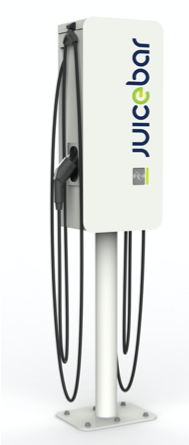Utility Demand Charges Keep Level 3 Charging Stations Dark
We have quite a few posts addressing range-anxiety in its various forms. Even though most EVs have enough range to get you through your typical day, we all have occasions where we drive to a destination that exceeds the range of the vehicle. Without the certainty of being able to charge en-route, there is the danger of the battery turning into a very heavy brick. This possible low frequency, but high impact, event is enough to give pause for many folks considering an EV purchase.
A particular CT flavor of this can be found at rest areas on I-95 and the Merritt Parkway. For example, the I-95 southbound rest area in Darien and the Merritt Parkway northbound rest area in Greenwich have CCS and CHAdeMo level 3 chargers that aren’t working. (Presumably, this is the case at other rest areas that we haven’t been to). These charging stations are not broken. They are just turned off.
The reason is simple: demand charges.
What are demand charges
Utilities build out their infrastructure to handle anticipated peak demand. Demand charges are what pay for that. For non-residential classes of clients, the utility imposes demand charges based on their peak power usage and they are substantial. Whereas a residential user pays a cost per kilowatt-hour charge typically of approximately 17 – 20 cents, demand charges could be over $13 per kWh, plus a higher distribution fee. If you would like to see for yourself, here is the (complicated) rate structure used by Eversource.
Demand charges have been around for around 100 years, since the early expansion of electric service throughout the country. Aside from paying for infrastructure expansion, they are intended to spread demand into non-peak usage times in order to lessen the need for that expensive infrastructure.
Electric vehicle charging stations obviously draw current, especially the level 3 DC fast chargers that are needed along the Interstates to facilitate a long drive. The power-draw required to obtain an 80% charge in 15 – 30 minutes is sufficiently high (especially if multiple chargers are in simultaneous use) that the threshold for demand charges may kick-in. Our information is that the companies that run the food and gas service at the rest areas did not install the chargers, and it was a shock (electricity makes for way too easy puns) to them when they saw what demand charges were doing to their electric bill. So they turned them off.
Why Demand Charges for EVs Require Rethinking
While demand charges have served a purpose, it is time to rethink how these are handled with respect to EVs for a few reasons.
- Lack of charging infrastructure is a major barrier to EV adoption, and EVs are an important factor in mitigating climate change. In this sense, an inability to charge undercuts a social good.
- Utilities are the new fuel stations. They stand to reap a tremendous amount of business with widespread EV adoption. With EV charger demand charges, they are working against themselves.
- EVs will stimulate use in off-peak hours. Most charging, over 80%, is done at home, and most of this is done at night. In other words, EVs bring load-management benefits to the utilities. If there were a more robust time-of-use rate card available in CT, this would be even more true. Also, at a presentation done at DEEP in January 2019, Dana Lowell of M.J. Bradley Associates stated that the excessive (for want of a better term) net revenue resulting from EVs in this heavily regulated industry would be returned to the ratepayers. In the EV nirvana of 2 million EVs registered in the state, he estimated it would amount to $150 annually per household.
- This is speculative at this point, and a little off-topic, but it is technically possible for EV batteries to be bi-directional, also

Electric school bus funded by Con Ed that is part of a test of vehicle-to-grid charging protocols. referred to as V2G (vehicle to grid). At times of peak demand, the energy residing in charged EV batteries could be tapped to fulfill demand, and then be recharged when demand subsides. The part of this that is on point is that there needs to be a lot of battery capacity out there to make this a viable strategy. A pilot study intended to test the bi-directional technology, underwritten by Con-Edison, is being run in Westchester County with electric school buses.
The bottom line is that EVs come with more ramifications with respect to the grid, and more opportunities for society as a whole, than a factory or commercial building. Other states are further along than CT in bringing innovation to approaching this dilemma.
To be sure, demand charges are just a single piece of the larger EV policy puzzle. It is a subset of what is referred to as “rate-design.” DEEP produced a 71-page “Draft EV Roadmap” that does a good job of covering the waterfront in terms of all related policy areas, though the language in this document, released in October 2019, is worded in terms of evaluation or investigation. In other words, there is still a long way to go. The section on demand charges is on page 44.
Tesla Chargers
There are Tesla chargers on the Interstates and these do work. That is because Tesla takes responsibility for them. They may be carrying a contingent liability, but their forward-thinking decision to install their own charging network and not wait for the rest of the world to catch up means that Tesla drivers have a wider array of charging options.
Waiver
There is an Eversource program to grant a demand charge waiver for independently metered charging stations that are open to the public, but that the waiver is temporary. It substitutes average per kWh charges. We don’t have a sense that this has been promoted aggressively. The waiver was for 3 years, but the clock has been ticking and it is currently closer to 2 years. A temporary waiver doesn’t really accomplish much unless there is something in place to address the underlying problem when it expires.
There are options other than an outright waiver to address this. We reached out to Eversource and were advised that the Public Utility Regulatory Authority will review the rate after the 3 year period ends and decide if changes are needed to the rate structure.

